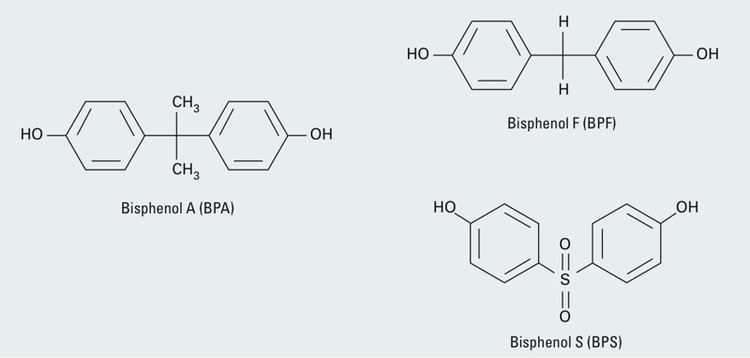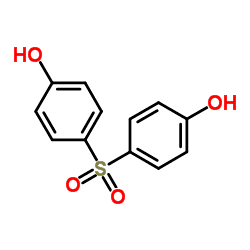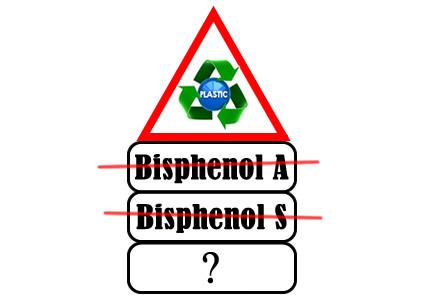Formula C12H10O4S Density 1.37 g/cm³ | Molar mass 250.275 g/mol | |
 | ||
Appearance White colorless solid; forms needle shaped crystals in water | ||
Bisphenol S (BPS) is an organic compound with the formula (HOC6H4)2SO2. It has two phenol functional groups on either side of a sulfonyl group. It is commonly used in curing fast-drying epoxy resin adhesives. It is a bisphenol, and a close analog of bisphenol A (BPA) in which the dimethylmethylene group (C(CH3)2) is replaced with a sulfone group (SO2).
Contents

Use

BPS is used in curing fast-drying epoxy glues and as a corrosion inhibitor. It is also commonly used as a reactant in polymer reactions.

BPS has become increasingly common as a building block in polycarbonates and some epoxies, following the widespread belief that BPA has estrogen-mimicking properties, and enough of it remains in the products to be dangerous. BPS is now used to a variety of common consumer products. In some cases, BPS is used where the legal prohibition on BPA allows products containing BPS to be labelled "BPA free". BPS also has the advantage of being more stable to heat and light than BPA.

To comply with restrictions and regulations on BPA due to its confirmed toxicity, manufacturers are gradually replacing BPA with other related compounds, mainly bisphenol S, as substitutes in industrial applications.

BPS is also used as an anticorrosive agent in epoxy glues. Chemically, BPS is being used as a reagent in polymer reactions. BPS has also been reported to occur in canned foodstuffs, such as tin cans.

In a recent study analyzing BPS in a variety of paper products worldwide, BPS was found in 100% of tickets, mailing envelopes, airplane boarding passes, and airplane luggage tags. In this study, very high concentrations of BPS were detected in thermal receipt samples collected from cities in the United States, Japan, Korea, and Vietnam. The BPS concentrations were large but varied greatly, from a few tens of nanograms per gram to several milligrams per gram. Nevertheless, concentrations of BPS used in thermal paper are usually lower compared to those of BPA. Finally, BPS can get into the human body through dermal absorption from handling banknotes.
Environmental considerations
Recent work suggests that, like BPA, BPS also has endocrine disrupting properties. What makes BPS, and BPA, endocrine disruptors is the presence of the alcohol group on the benzene ring. This is called a phenol ring and it allows BPA and BPS to mimic estradiol. In a study of human urine, BPS was found in 81% of the samples tested. This percentage is comparable to BPA which was found in 95% of urine samples. Another study done on thermal receipt paper shows that 88% of human exposure to BPS is through receipts.
The recycling of thermal paper can introduce BPS into the cycle of paper production and cause BPS contamination of other types of paper products. A recent study showed presence of BPS in more than 70% of the household waste paper samples, potentially indicating spreading of BPS contamination through paper recycling.
BPS is more resistant to environmental degradation than BPA, and although not persistent cannot be characterised as readily biodegradable.
History
BPS was first made in 1869 as a dye and is currently common in everyday consumer products. BPS is an analog of BPA that has replaced BPA in a variety of ways, being present in thermal receipt paper, plastics, and indoor dust. After health concerns associated with bisphenol A grew in 2012, BPS began to be used as a replacement.
Regulation
It is difficult for consumers to determine if a product contains BPS due to limited labeling regulations.
Synthesis
Bisphenol S is prepared by the reaction of two equivalents of phenol with one equivalent of sulfuric acid or oleum.
2 C6H5OH + H2SO4 → (C6H4OH)2SO2 + 2 H2O2 C6H5OH + SO3 → (C6H4OH)2SO2 + H2OThis reaction can also produce 2,4'-sulfonyldiphenol, a common isomeric complication in electrophilic aromatic substitution reactions.
